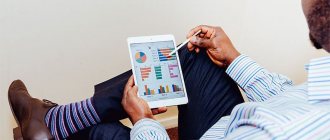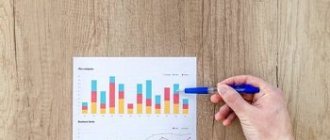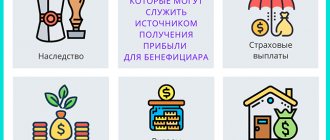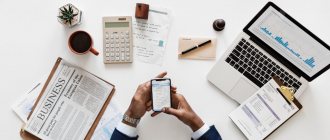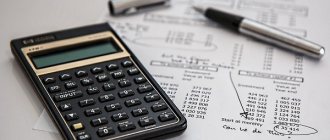Assets and liabilities make up the two parts of the balance sheet.
Assets are everything that an organization has: tangible and intangible property and finances. Liabilities are the sources through which assets are formed: authorized, share and borrowed capital.
Assets must necessarily equal liabilities, because the former are formed at the expense of the latter. That is, any change in assets results in a change in liabilities by the same amount and vice versa.
Simply put , property cannot come out of nowhere, and capital or credit should not be spent on something that is not accounted for on the balance sheet.
What is a liability in accounting?
Liability is a component of the balance sheet. Information from accounting documents will provide the following data:
- objects that are owned by the enterprise;
- financial performance results;
- sources of company funds.
What are the features of filling out the liabilities side of the balance sheet ?
Assets reflect information about the property of the enterprise. Liabilities allow you to determine the sources of available capital. On the right side of the accounting table the following is recorded:
- The enterprise's own funds (include the authorized capital, as well as profits that have not been distributed).
- Loans and credits.
- Funds that were raised.
the sources of property formation grouped in the liabilities side of the balance sheet ?
To simplify things, liabilities are sources of assets. This connection is due to the fact that liability management leads to an increase in assets. Liabilities and assets are inextricably linked. They form a balance. The accounting spreadsheet has this name due to the fact that the liability is equal to the asset. Both indicators balance each other.
IMPORTANT! Asset and liability reflect the main principle of accounting - the principle of double entry.
Example
The essence of assets or liabilities is easier to understand from an example. The company takes out a loan of 2,000,000 rubles. This operation must be reflected in accounting:
- 2 million are reflected in the accounts. They must be recorded in the list of assets;
- 2 million are indicated in the “Loan debts” account. The indicator must be recorded in the list of liabilities.
That is, information about the receipt of funds can be obtained from assets. From liabilities, the source of money becomes clear - lending.
conclusions
Brief conclusions of the lesson:
- Everything a company has can be divided into A. and P.
- A. is property, accounts receivable, issued credits and loans, their purpose is to generate profit.
- P. is capital, reserves, debts, liabilities, their purpose is to create A.
- The total amount of P. is always equal to the total amount of A.
- Any change in P. entails a change in A. by the same amount.
- The balance sheet shows the results of activities and allows you to check the correctness of accounting.
The full course “Accounting from scratch” can be purchased at this link »»».
There is a 25% discount until April 30, 2022 .
Types of liabilities
Liabilities are divided into three types:
- The enterprise's own reserve funds. Formed from authorized and share capital.
- Long-term liabilities are loans that need to be repaid within a year or more. These may include deferred tax liabilities.
- Short-term liabilities are loans that need to be repaid in less than a year. They may include not only loans, but also obligations and debts to employees of the enterprise, reserves for further expenses.
ATTENTION! From liabilities alone you can learn a lot about the activities of the enterprise. The stability of the company is ensured by its own funds. The more personal capital an enterprise has, the more independent it is. A manager should be wary of a large share of borrowed funds. This increases the enterprise's dependence on creditors. In a critical financial situation, it will be difficult for an organization to repay debts, which can lead to bankruptcy.
Rules for drawing up a balance sheet
Let's look at what accounting indicators should be reflected in the active part of the balance sheet. Here is a breakdown of the accounts and indicators of the reporting form:
| Structure | What to include |
| I. NON-CURRENT | |
| Intangible assets | The residual value of the enterprise's intangible assets should be reflected here. Determine the value as the difference between account 04 “Intangible assets” and 05 “Depreciation of intangible assets”. When calculating, exclude values corresponding to data on the results of research and development, as well as information on intangible exploration assets. |
| Research and development results | If an organization conducts research activities and the results of R&D are listed on the balance sheet, then in this section of the balance sheet reflect the residual value of R&D in account 04. |
| Intangible search assets | Filled out by organizations that conduct natural resource development and exploration activities. Economic entities reflect information about such objects on account 08. If an object has a tangible-material shell, then it is a material search asset, intangible ones - without a form, shell, or structure. Please note that for search assets, depreciation is calculated on accounts 02 and 05. |
| Material prospecting assets | |
| Fixed assets | Residual value of fixed assets. Determine the difference between the initial cost of account 01 and accrued depreciation, the balance of account 02. |
| Profitable investments in material assets | Reflect the difference between the balances on account 03 and the accrued depreciation for the corresponding accounting objects (account 02). |
| Financial investments | These are long-term financial investments with a maturity of at least 12 months. For example, reflect the account balance 55 if there are deposits opened for a period of more than 12 months. Also reflect long-term investments in accounts 58 (financial investments) and 73 (loans to employees of the institution). Reduce the balance on account 58 if the organization has created a reserve for the account. 59. |
| Deferred tax assets | Reflect the account balance. 09. Indicators are reflected in accordance with PBU 18/02. |
| Other noncurrent assets | Reflect other types of non-current assets that are not included in the group presented above. Also in this section you can reflect those objects about which it is not necessary to indicate information, but the company considers it necessary to include information in the balance sheet. |
| Total for Section I | The total for the corresponding section is generated. |
| II. NEGOTIABLE | |
| Reserves | Reflect the amount of balances on accounts 10, 11 (minus the reserve recorded on account 14), 15, 16, 20, 21, 23, 28, 29, 41 (minus account 42, if goods are recorded with a markup), 43, 44, 45, 46, 97. |
| Value added tax on purchased assets | Include information about the ending account balance. 19 "VAT". |
| Accounts receivable | To obtain the indicator, debit balances on accounts 60, 62 (both accounts minus the reserves formed on account 63), 66, 67, 68, 69, 70, 71, 73 (minus the data recorded under the item “Financial investments”) are summed up. , 75, 76. Do not include the credit balance in the calculation. |
| Financial investments (excluding cash equivalents) | These are deposits, financial investments, loans to employees with a maturity of less than 12 months. We form account balances. 55, 58, 73. We take into account the reserve on the account. 59, we subtract it if there is a balance. |
| Cash and cash equivalents | The actual money of the company listed in accounts 50, 51, 55 (except for the deposit), 52, 57 as of the reporting date. We reflect the amount of the debit balance. |
| Other current assets | Reflect other types of current assets that are not included in the group presented above. Also in this section you can reflect those objects about which it is not necessary to indicate information, but the company considers it necessary to include information in the balance sheet. |
| Total for Section II | The total value of the section indicators. |
| BALANCE | Sum of section 1 and 2. |
Differences between own and borrowed liability objects using an example
It was already indicated above that the structure of the balance sheet gives an idea of the stability of the company. Availability of own funds is a serious advantage of the enterprise. Proper use of liabilities will ensure independence and well-being.
An example of using your own funds. The company bought premises for offices. The property is for rent. Rental funds continuously flow into the company's budget. The organization receives net profit that does not imply liabilities. Funds can be used both for capital formation and for increasing turnover. Profits do not decrease due to inflation, since office rental prices are constantly rising.
An example of the use of borrowed funds. The company took out a million rubles on credit to rent retail space and purchase a batch of products. The loan was short-term. The premises were rented. Products are displayed on the trading platform. The product became popular among consumers. In just a few months, we managed to receive more than 2 million rubles. The million was used to repay the loan.
But another situation is also possible. The company took out a million rubles on credit. The money was also used for rent and purchase of products. However, the product was not successful with the consumer. In a few months we managed to get 200,000 rubles. There was not enough money for the subsequent rent of the retail space, as well as for repaying the loan on time. Creditors went to court to collect the debt. The company had to declare itself bankrupt.
ATTENTION! Based on the examples given, it becomes clear that it is beneficial for an enterprise to have its own reserves. However, most enterprises also have borrowed funds. This is completely normal. The main thing is to monitor the proportions between your own and borrowed funds.
Results
The balance sheet is the main component of financial statements, a summary of the financial performance of an organization as of a certain date. It is drawn up in a certain form and according to certain rules. It is submitted to the tax office and also presented to other interested users. Starting from June 1, 2022, you must use the form as amended on April 19, 2019.
Sources:
- Order of the Ministry of Finance of Russia dated April 19, 2019 N 61n
- Order of the Ministry of Finance of the Russian Federation dated October 31, 2000 N 94n
You can find more complete information on the topic in ConsultantPlus. Free trial access to the system for 2 days.
Liability structure
Most of the liabilities consist of various obligations of the enterprise: loans, borrowings, debts to employees or counterparties. Obligations are divided into these types:
- Imaginary . These include money that was provided by the owner of the company, debts that have expired. Imaginary obligations can be conditionally called extinguished. They are recorded in accounting and tax accounting. Taking them into account protects the organization from double payments. The cost of turnover will not decrease.
- Hidden . Obligations that appear in official documentation, however, do not actually exist. They appear when repaid debts are not entered in the accounting records on time. Hidden liabilities include deferred tax liabilities, contributions for charity, and coverage of debts of the company's branches.
- Actual . Such obligations actually exist and are correctly reflected in the balance sheet. They include debts to banking and credit institutions, staff, and shareholders.
Obligations are a heterogeneous structure. To understand the position of the company, it is important to analyze the composition of liabilities.
Tutorial for beginners from scratch
An accessible tutorial “Accounting from scratch in 14 days” for learning the basics of accounting for novice accountants.
The tutorial consists of:
- educational book with lessons;
- a collection of problems with answers and solutions;
- an example of accounting with year-end closing;
- legislative basis of the current version: PBU, Chart of Accounts, Law “On Accounting” in pdf format.
We also recommend reading:
- Lesson 1. What is accounting - briefly in simple words about accounting in general
- Lesson 3. What are accounting accounts and why are they needed?
- Lesson 4. How to quickly and easily make transactions?
- Lesson 5. What are primary documents and why are they needed?
- Lesson 6. Accounting policy of the organization - why is it needed and how to draw it up?
- Lesson 7. Accounting for authorized capital on account 80 - what is it and why is it needed?
- Lesson 8. Settlements with founders for contributions to the authorized capital (account 75)
- Lesson 9. Cash accounting (account 50)
Liability Analysis
Liability analysis includes the following measures:
- Estimation of shares of short-term and long-term liabilities.
- Determining the number of liquid assets that can serve as a source of repayment of debts from the liability column.
- Valuation of shares of own and borrowed funds.
The analysis allows you to build a development plan for the enterprise aimed at increasing its own funds. The indicators provide timely monitoring of the company's difficult financial situation.
So, let's remember:
- Liability is a component of the company's balance sheet.
- Reflects the sources of assets.
- Liabilities may include short-term and long-term liabilities, authorized capital, and debts to employees.
- Obligations are divided into many categories: imaginary, hidden, actual. The company's liabilities can and should be analyzed. They reflect the stability of the company, its independence from creditors.
- Based on the obtained indicators, you can draw up a plan that will help improve the well-being of the enterprise.
Asset liquidity
Non-current and current assets are not the only grouping, although it is used in the balance sheet. Analysts divide assets into four groups according to the degree of liquidity, that is, the ability to turn into money:
- absolutely liquid assets (A1) are property that can be converted into money as quickly as possible, for example, cash and securities themselves;
- medium-liquid assets (A2) - property that can be sold without much difficulty, for example, goods, finished products and accounts receivable;
- weakly liquid assets (A3) - property with a long sale period, for example, raw materials, work in progress;
- illiquid assets (A4) - property that is difficult to sell, for example, equipment, building, long-term receivables.
This division is very conditional and depends on the specific property. For example, selling raw materials in the form of galvanized metal sheets is much easier than selling carboxymethyl cellulose. The same applies to equipment: it will be easier to sell a drilling machine than a polypropylene blowing line.


